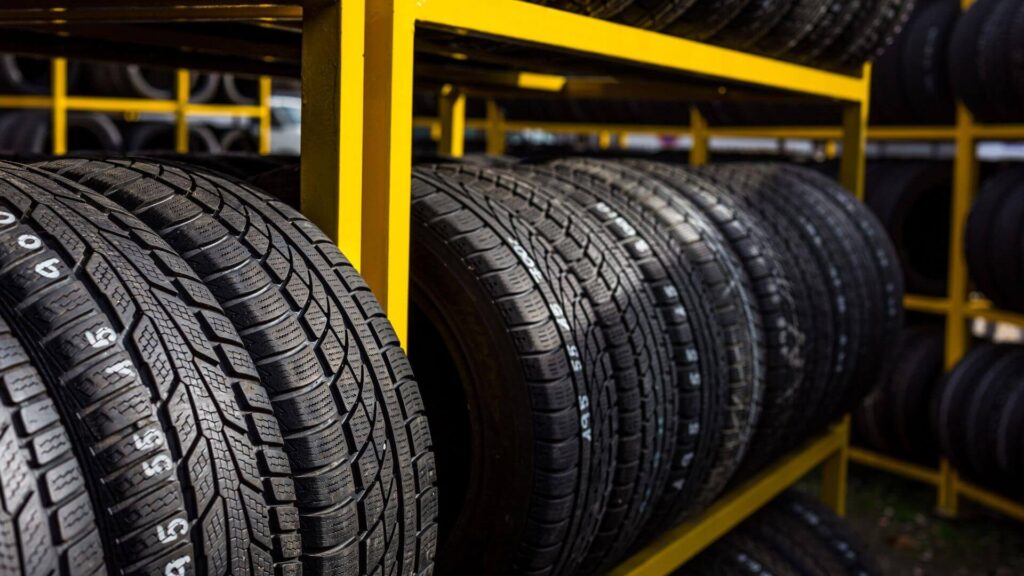Proper tire warehousing and storage is a crucial aspect of managing a business, especially if you deal with tires as part of your inventory. Whether you’re an automotive shop, a tire retailer, or a distributor, ensuring that your tires are stored correctly can significantly impact their longevity, safety, and overall quality.
In this comprehensive guide, we’ll walk you through the best practices for storing tires at warehousing facilities to help you preserve their value and performance.
What are the Importance of Proper Tire Storage?
Proper tire storage is a critical component of tire management for businesses involved in the automotive industry. Whether you are an auto repair shop, tire retailer, or distributor, understanding the profound importance of storing tires correctly is paramount to preserving their value, ensuring safety, and maintaining their overall performance.
- Safety Assurance
Safety is a paramount concern when it comes to tire storage. Incorrectly stored tires can pose severe safety risks within warehousing facilities. Stacks of improperly arranged tires may topple over, leading to accidents and injuries, especially in bustling warehouse environments. Ensuring that tires are securely and systematically stored mitigates these safety hazards, protecting both employees and customers.
- Preservation of Tire Integrity
The preservation of tire integrity is another pivotal reason to prioritize proper storage. Tires are constructed with specific materials and designs to endure the rigors of the road. However, when stored improperly, they are susceptible to damage and premature aging. Exposure to sunlight, extreme temperatures, and moisture can degrade the rubber compounds in tires, leading to reduced lifespan and compromised performance. Proper storage shields tires from these environmental factors, helping to maintain their structural integrity.
- Enhanced Customer Satisfaction
The condition of the tires you provide to customers directly impacts their satisfaction and road safety. Well-preserved tires are more likely to deliver optimal performance, longevity, and safety. When customers receive tires that are in prime condition, they are more likely to trust your business and return for future purchases or services. Proper storage practices, therefore, contribute significantly to customer satisfaction and loyalty.
- Cost Efficiency
Cost efficiency is a critical consideration for any business. Proper tire storage directly affects your bottom line. By implementing effective storage methods, you can minimize tire damage and reduce the need for premature replacements which translates to cost savings in the long run. Well-maintained tires last longer and require fewer replacements, maximizing your return on investment and minimizing operational expenses.
In summary, proper tire storage at a designated warehousing facility is not merely a routine logistics task; it is a fundamental aspect of responsible tire management. It ensures safety within your facility, preserves the integrity and performance of your tire inventory, enhances customer satisfaction, and ultimately drives cost efficiency. By adhering to best practices in tire storage, businesses can protect their assets, reputation, and financial viability.
7 Best Practices While Storing Tires at Warehousing Facilities
As mentioned earlier, implementing best practices for tire storage not only ensures the longevity and safety of your tire inventory but also enhances cost-efficiency and customer satisfaction. Let’s take a look at seven key practices to follow when storing stores at warehousing facilities.
1. Choose the Right Location
First up, selecting the right storage location is the cornerstone of effective tire storage practices, as it directly impacts tire quality and longevity. Here are the key considerations when determining the optimal storage location for tires:
Indoor vs. Outdoor
Whenever feasible, prioritize indoor storage for your tire inventory. Indoor warehousing facilities offer several advantages:
- Indoor storage shelters tires from external elements such as sunlight, rain, snow, and extreme temperatures. These environmental factors can accelerate tire degradation and reduce its lifespan.
- Indoor storage areas are generally more secure and less susceptible to theft or vandalism, providing added protection for your valuable tire inventory.
- Indoor environments typically maintain more stable temperature and humidity levels, minimizing fluctuations that can adversely affect tire rubber.
Climate Control
Opting for climate-controlled storage facilities is especially important when indoor space is unavailable or when storing tires in extreme temperature environments:
- Climate-controlled storage facilities maintain a stable temperature within the recommended range, which usually falls between 32°F to 77°F (0°C to 25°C). This stability is crucial to prevent tire degradation caused by exposure to extreme heat or cold.
- Climate control also helps regulate humidity levels, preventing excess moisture that can lead to rust on steel rims and hasten rubber decay.
Cleanliness
Ensuring the cleanliness of the storage area is vital or preserving tire quality and preventing contamination.
- Keep the storage area clean and free from debris, dust, and potential contaminants such as chemicals, oil, or solvents. These substances can harm tire rubber and compromise their performance.
- Implement a routine cleaning and maintenance schedule for the storage area. Regularly sweep and clean the floors to maintain cleanliness and prevent tire contamination.
Selecting the optimal storage location for your tire inventory, whether indoor or climate-controlled, and maintaining a clean environment, plays a pivotal role in prolonging tire lifespan, preserving quality, and ensuring that your tires remain safe and reliable when they are eventually used or sold.
2. Use Proper Racking and Stacking
Efficient tire storage hinges on the adoption of suitable racking and stacking techniques that maximize space utilization, ensure safety, and preserve the quality of tires. Here’s a closer look at how to implement proper racking and stacking techniques.
Pallet Racks
Investing in specialized pallet racks designed explicitly for tire storage is a fundamental practice. These racks are purpose-built to accommodate the unique characteristics of tires. Key considerations include:
- Tire racks are designed to provide stability and support for the weight of multiple tires. Ensuring the structural integrity of these racks is crucial to prevent accidents or damage to the stored tires.
- Tire racks are configured to optimize space utilization. They allow tires to be stored in an organized and efficient manner, reducing clutter and facilitating easy access.
- Proper tire racks ensure that tires are easily accessible when needed. This accessibility streamlines inventory management and minimizes handling efforts, improving overall operational efficiency.
Stacking Height
Careful consideration of stacking height is pivotal to tire storage safety and effectiveness. It’s essential to adhere to the recommended guidelines:
- Avoid stacking tires excessively high. A generally advisable maximum height ranges from 4 to 6 feet, and going beyond this height threshold can pose a risk of toppling, which not only endangers personnel but can also result in damage to tires. Ensuring that stacks are within this height range is a preventive measure against accidents.
Stacking Patterns
Adopting consistent stacking patterns within your tire storage system is essential to evenly distribute weight and maintain stability within stacks:
- Stacking tires side by side is a common practice. This pattern distributes the load evenly across the tire treads, reducing the risk of deformation.
- Another effective method is alternately orienting tires within the stack. This means that one tire’s sidewall faces another tire’s tread and vice versa. This practice helps evenly distribute the weight and enhances stack stability.
Proper racking and stacking methods not only enhance the organization and accessibility of stored tires but also contribute significantly to safety and tire preservation. Investing in purpose-built tire racks, adhering to recommended stacking heights, and maintaining consistent stacking patterns are integral elements of an efficient and safe tire storage system, whether for a tire shop, service center, or warehousing facility.
3. Maintain Correct Tire Positioning
Proper tire positioning is a fundamental aspect of tire storage to ensure tires retain their intended shape and performance characteristics. Here’s a closer look at how to maintain correct tire positioning.
Vertical Storage
Vertical storage is a key practice to prevent tire deformation, particularly a condition known as “flat spotting.” Flat spotting occurs when the weight of a tire, especially when stored horizontally for extended periods, causes it to develop a flattened area at the point where it contacts the ground or another surface. To maintain proper tire shape:
- Store tires upright and vertically on their treads. This helps to minimize the contact area with the ground, reducing the risk of flat spotting.
- Invest in specialized tire racks designed for vertical storage. These racks provide stability, help optimize storage space, and ensure that tires remain in an upright position.
- Periodically inspect stored tires for any signs of flat spotting or deformities. If you notice flat spots developing, consider rotating or repositioning the tires to distribute the load more evenly.
Rotation of Tire Positions
Periodically rotating tire positions within your inventory is another critical practice to prevent flat spotting and ensure that tires age uniformly, particularly during long-term storage:
- Implement a rotation schedule for your tire inventory. The frequency of rotation can vary depending on factors such as storage duration and the specific tire types you deal with. In general, aim to rotate tires every six months to a year for long-term storage.
- When rotating tires, aim to alternate their positions within the stack or on the rack. For example, if a tire has been at the bottom of a stack for some time, move it to the top or reposition it within the rack.
- Maintain proper documentation of tire positions and rotation schedules. Label tires with information about their position and the date of rotation to track their usage and ensure uniform wear.
- While rotating tires, take the opportunity to inspect them for signs of damage, aging, or wear. This ensures that any potential issues are identified and addressed promptly.
Proper tire positioning, through vertical storage and regular rotation, helps safeguard the structural integrity and performance of your tire inventory. By preventing flat spotting and ensuring even wear, you not only extend the lifespan of the tires but also enhance their safety and reliability when they are eventually used or sold.
4. Monitor Tire Pressure
Tire pressure is a critical factor in preserving the integrity and performance of tires. Proper inflation not only ensures safety but also extends the lifespan of your tire inventory. Here’s a comprehensive look at why and how to effectively monitor tire pressure:
Pressure Inspections
Implementing a systematic schedule for tire pressure inspections is essential. Here’s how to go about it:
- Conduct regular pressure inspections, ideally at least once a month. However, consider more frequent checks in certain conditions, such as during extreme temperature fluctuations or when tires are in long-term storage.
- Invest in high-quality tire pressure gauges. Both digital and analog gauges are available, but digital gauges tend to provide more accurate readings.
- Refer to the tire manufacturer’s specifications for the recommended tire pressure. This information can usually be found in the vehicle owner’s manual, on a sticker inside the driver’s door jamb, or in the glove compartment.
- Ensure that the tires are cool before checking their pressure. Tires warm up during driving, which can affect pressure readings. It’s best to check them when they are cold.
- Always use valve caps to prevent dust and debris from entering the valve stem. This simple measure can help maintain accurate pressure readings.
Inflate or Deflate Tires to Recommended Levels
Once you’ve inspected the tire pressure, take appropriate action:
- If the pressure is below the recommended level, use an air compressor to inflate the tire to the specified PSI (pounds per square inch). Overinflating tires can be just as damaging as underinflating, so adhere to the manufacturer’s guidelines.
- If the tire pressure is too high, release some air until it reaches the recommended level. Avoid over-deflating, as this can also lead to tire damage or deformation.
Importance of Correct Tires Pressure
Maintaining the correct tire pressure offers several benefits:
- Properly inflated tires provide optimal traction and handling, reducing the risk of accidents.
- Correct tire pressure improves fuel efficiency by reducing rolling resistance.
- Overinflated or underinflated tires wear unevenly, decreasing their lifespan. Proper inflation ensures even wear.
- Well-inflated tires provide a smoother and more comfortable ride.
- Correct tire pressure enhances vehicle handling and overall performance.
By adhering to a routine schedule of pressure inspections and promptly inflating and deflating tires to the recommended levels, businesses can ensure that their tire inventory remains in top condition. This not only contributes to safety but also extends the life of the tires, maximizing their value and performance.
5. Protect Against Environmental Factors
Environmental conditions can have a significant impact on the condition and lifespan of tires. It’s crucial to take proactive measures to shield tires from these factors to ensure their longevity and performance. Here’s a comprehensive look at how to protect tires against environmental elements:
Cover Tires
Shielding tires from direct sunlight and UV (ultraviolet) radiation is essential to prevent rubber degradation and maintain tire integrity. Here’s how to go about it:
- Invest in specialized tire covers designed to protect tires from sunlight and UV radiation. These covers are made from materials that effectively block UV rays and shield the tires.
- For a cost-effective option, consider placing each tire inside an opaque plastic bag. Ensure that the bags are sealed to prevent moisture and UV exposure. This method is particularly useful for long-term storage.
- When storing tires outdoors, cover them with durable, UV-resistant tarps. Ensure that the tarps are secured tightly to prevent wind or weather from exposing the tires.
Climate Control
In environments where temperature and humidity control is challenging, such as outdoor storage, consider these measures to combat excess moisture and temperature extremes:
- Install dehumidifiers in indoor storage spaces to regulate humidity levels. Excess moisture can lead to rust on steel rims and accelerate rubber decay. Dehumidifiers help maintain a drier environment, reducing these risks.
- Utilize moisture-absorbing products such as desiccant packs or moisture-absorbing bags. Place these products strategically within the storage area to trap excess moisture and prevent it from affecting the tires.
- If available, opt for climate-controlled storage facilities, especially for valuable or sensitive tires. These facilities maintain stable temperature and humidity levels within the recommended ranges, ensuring optimal tire preservation.
By implementing these protective measures against environmental factors, businesses can significantly extend the lifespan of their tires and prevent premature degradation. Whether you’re storing tires indoors or outdoors, safeguarding them from sunlight, UV radiation, moisture, and temperature extremes is essential to maintain tire quality and safety.
6. Implement Inventory Management
Efficient inventory management is a crucial aspect of tire storage that not only helps track tire conditions but also optimizes their usage and maintenance. Here’s a more comprehensive look at how to effectively manage your tire inventory.
Labeling
Proper labeling of each tire is an essential step in maintaining efficient inventory management. Labeling should include the following vital information:
- Clearly identify the tire type or model to ensure that the right tires are used for specific vehicles or purposes.
- Record the date when each tire was placed in storage. This date serves as a reference point for monitoring the age of the tires.
- Regularly assess and update the condition of each tire by using a standardized condition rating system, such as a numerical scale or descriptive terms (e.g., “excellent,” “good,” “fair,” “poor”). This condition assessment is critical for identifying tires that may require maintenance or should be prioritized for use or sale.
FIFO Systems (First In, First Out)
Implementing the FIFO systems is an effective practice to ensure that older tires are used or sold before newer ones. This practice aligns with the principle of using tires in the order they were received, minimizing the risk of tires aging excessively during prolonged storage. Here’s how to effectively apply the FIFO system:
- Arrange your tire storage in a way that allows easy access to the oldest tires first. This could involve stacking or racking tires in a manner that ensures the older ones are readily accessible.
- Conduct regular inspections of your tire inventory to identify tires that have been in storage the longest. These are the ones you should prioritize for use or sale.
- Maintain records of tire usage, including installation dates and vehicle or customer information. This documentation helps ensure that older tires are indeed being used in accordance with the FIFO system.
Efficient inventory management not only helps extend the lifespan of tires but also aids in making informed decisions about maintenance, rotation, and disposal. By labeling tires with essential information and practicing the FIFO system, you can optimize tire usage, reduce the risk of tire aging, and enhance the overall management of your tire inventory.
7. Enhance Security Measures
Ensuring the security of your tire inventory is paramount to protect your valuable assets from theft, damage, or unauthorized access. Here’s a comprehensive look at how to enhance security measures for your tire storage.
Security Cameras
Installing security cameras in and around the storage area serves as a proactive deterrent and a valuable tool for monitoring and recording activities. Here’s how to effectively utilize security cameras:
- Position security cameras strategically to cover all key areas within and around the storage facility, including entry points, exit points, and the entire storage space.
- Ensure that the cameras are operational 24/7 and have adequate recording capacity. Regularly review camera footage to detect any suspicious activities or incidents.
- Display visible signage indicating that the area is under video surveillance. This can deter potential thieves or vandals.
Access Control
Implementing strict access control measures helps restrict entry to authorized personnel only, safeguarding your tire inventory. Here’s how to enhance access control:
- Clearly define and maintain a list of authorized personnel who have access to the storage area. Ensure that only individuals with legitimate reasons for accessing the tires are on this list.
- Strengthen the security of entry points such as gates, doors, or access points. Use locks, access control systems, or key cards to prevent unauthorized entry.
- Keep a visitor log to record the entry and exit of anyone accessing the warehousing facility. This log should include names, entry times, and reasons for visitation.
- Train employees on security protocols and the importance of safeguarding the tire inventory. Encourage them to report any suspicious activities or security concerns promptly.
- Conduct regular security audits to assess the effectiveness of access control measures. Make necessary adjustments based on audit findings.
By investing in security cameras, implementing access control measures, and maintaining a vigilant security posture, businesses can significantly reduce the risk of theft, unauthorized access, or damage to their tire inventory. These security enhancements not only protect valuable assets but also provide peace of mind and assurance that your tires are secure and kept in optimal condition.
Conclusion
By diligently adhering to these best practices while storing tires at warehousing facilities, businesses can safeguard the condition and value of their tire inventory. Proper tire storage not only ensures tires are in prime condition when needed but also contributes to enhanced safety, customer satisfaction, and overall cost-efficiency. It underscores that tire storage is not merely a logistical task but an investment in the reputation and success of the business.
Tyre Warehousing FAQs
These FAQs provide insights into various aspects of tire warehousing, helping businesses make informed decisions and maintain the quality and safety of their tyre inventory.
Are there specific storage requirements for seasonal or specialty tyres?
Seasonal and specialty tyres may have unique storage requirements. Consult the tyre manufacturer’s guidelines for proper handling and storage.
How can I extend the lifespan of tyres in storage?
You can implement proper storage conditions, including correct tyre pressure, protection from environmental factors, and regular inspections, which can extend the lifespan of stored tyres.
What should I do if I discover damaged or deteriorated tyres in storage?
You can remove damaged tyres from inventory to prevent potential safety hazards, and consider tyre disposal or recycling options based on the extent of the damage.
Can I use an outdoor storage facility for tyre warehousing?
While outdoor storage may be necessary in some cases, it presents challenges due to exposure to the elements. Protective measures like tyre covers are recommended for outdoor storage.
Are there specific regulations or standards for tyre warehousing?
Regulations may vary by location, but it’s essential to adhere to safety and environmental standards when warehousing tyres. You should consult local authorities for specific requirements.
What is the role of tyre manufacturers in tyre warehousing recommendations?
Tire manufacturers often provide guidelines for proper tyre storage and handling. It’s advisable to follow their recommendations to ensure tyre quality.











